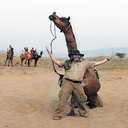0 Likes





France is affectionately referred to as "the Hexagon" for its overall shape.French history goes back to the Gauls, a Celtic tribe which inhabited the area circa 300BC until being conquered by Julius Caesar.The Franks were the first tribe to adopt Catholic Christianity after the Roman Empire collapsed. France became an independent location in the Treaty of Verdun in (843 AD), which divided up Charlemagne's Carolingian Empire into several portions.The French monarchy reached its zenith during the reign of Louis XIV, the Sun King, who stood for seventy-two years as the Monarch of all Monarchs. His palace of Versailles and its Hall of Mirrors are a splendid treasure-trove of Baroque art.The French Revolution ended the rule of the monarchy with the motto "Liberty, Equality, Fraternity!" On July 14th, 1789 angry mobs stormed La Bastille prison and began the Revolution in which Louis XVI, his wife Marie-Antoinette and thousands of others met the guillotine.One decade after the revolution, Napolean Bonaparte seized control of the Republic and named himself Emperor. His armies conquered most of Europe and his Napoleonic Code became a lasting legal foundation for concepts of personal status and property.During the period of colonization France controlled the largest empire in the world, second only to Britain.France is one of the founding members of the European Union and the United Nations, as well as one of the nuclear armed nations of the world.Text by Steve Smith.